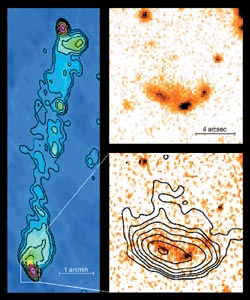
Radio galaxies are characterized by enormous jets, up to millions of light-years across, shooting out charged particles at up to almost the speed of light. Bright spots of emission are seen at the end of the jets where the particles plough into the surrounding intergalactic medium, depositing around 1044 erg/s in energy.
The exact details of where the particles reach such speeds and how they are accelerated are not clear. The Very Large Telescope in Chile was used to observe radio galaxy 3C445 at optical and near-infrared wavelengths. These observations may help to shed some light on the problem.
The jets of 3C445 extend outwards over 1.5 million light-years either side of the central galaxy. The new observations have been combined with previous observations at radio wavelengths, and show the progression of different areas of acceleration along the jet. The turbulent knots of emission highlight the areas where particles are accelerated, reaching energies that particle physicists can only dream of.
Picture of the Month

The planetary nebula known as “Little Ghost” is the relic of a star with a similar mass to that of our own Sun. After passing through the red giant stage, the star expelled its outer layers into space to leave a faintly glowing nebula and the core of the dying star in the centre. This image was taken using the Hubble Space Telescope. (ESA/NASA.)








